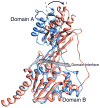Structure of zebrafish IRBP reveals fatty acid binding
- PMID: 26344741
- PMCID: PMC4624502
- DOI: 10.1016/j.exer.2015.08.026
Structure of zebrafish IRBP reveals fatty acid binding
Abstract
Interphotoreceptor retinoid-binding protein (IRBP) has a remarkable role in targeting and protecting all-trans and 11-cis retinol, and 11-cis retinal during the rod and cone visual cycles. Little is known about how the correct retinoid is efficiently delivered and removed from the correct cell at the required time. It has been proposed that different fatty composition at that the outer-segments and retinal-pigmented epithelium have an important role is regulating the delivery and uptake of the visual cycle retinoids at the cell-interphotoreceptor-matrix interface. Although this suggests intriguing mechanisms for the role of local fatty acids in visual-cycle retinoid trafficking, nothing is known about the structural basis of IRBP-fatty acid interactions. Such regulation may be mediated through IRBP's unusual repeating homologous modules, each containing about 300 amino acids. We have been investigating structure-function relationships of Zebrafish IRBP (zIRBP), which has only two tandem modules (z1 and z2), as a model for the more complex four-module mammalian IRBP's. Here we report the first X-ray crystal structure of a teleost IRBP, and the only structure with a bound ligand. The X-ray structure of z1, determined at 1.90 Å resolution, reveals a two-domain organization of the module (domains A and B). A deep hydrophobic pocket with a single bound molecule of oleic acid was identified within the N-terminal domain A. In fluorescence titrations assays, oleic acid displaced all-trans retinol from zIRBP. Our study, which provides the first structure of an IRBP with bound ligand, supports a potential role for fatty acids in regulating retinoid binding.
Keywords: Interphotoreceptor matrix; Interphotoreceptor retinoid-binding protein; Oleic acid; RBP3; Retina; Visual cycle; X-ray structure; Zebrafish.
Published by Elsevier Ltd.
Figures








Similar articles
-
Module structure of interphotoreceptor retinoid-binding protein (IRBP) may provide bases for its complex role in the visual cycle - structure/function study of Xenopus IRBP.BMC Biochem. 2007 Aug 4;8:15. doi: 10.1186/1471-2091-8-15. BMC Biochem. 2007. PMID: 17683573 Free PMC article.
-
Fold conservation and proteolysis in zebrafish IRBP structure: Clues to possible enzymatic function?Exp Eye Res. 2016 Jun;147:78-84. doi: 10.1016/j.exer.2016.05.001. Epub 2016 May 4. Exp Eye Res. 2016. PMID: 27155144 Free PMC article.
-
Cone outer segment and Müller microvilli pericellular matrices provide binding domains for interphotoreceptor retinoid-binding protein (IRBP).Exp Eye Res. 2013 Aug;113:192-202. doi: 10.1016/j.exer.2013.02.003. Epub 2013 Mar 5. Exp Eye Res. 2013. PMID: 23470504
-
Interphotoreceptor retinoid-binding protein (IRBP). Molecular biology and physiological role in the visual cycle of rhodopsin.Mol Neurobiol. 1993 Spring;7(1):61-85. doi: 10.1007/BF02780609. Mol Neurobiol. 1993. PMID: 8318167 Review.
-
Interphotoreceptor retinoid-binding protein: biochemistry and molecular biology.Prog Clin Biol Res. 1991;362:115-37. Prog Clin Biol Res. 1991. PMID: 2003123 Review.
Cited by
-
Single particle cryo-EM of the complex between interphotoreceptor retinoid-binding protein and a monoclonal antibody.FASEB J. 2020 Oct;34(10):13918-13934. doi: 10.1096/fj.202000796RR. Epub 2020 Aug 28. FASEB J. 2020. PMID: 32860273 Free PMC article.
-
Interphotoreceptor Retinol-Binding Protein Ameliorates Diabetes-Induced Retinal Dysfunction and Neurodegeneration Through Rhodopsin.Diabetes. 2021 Mar;70(3):788-799. doi: 10.2337/db20-0609. Epub 2020 Dec 17. Diabetes. 2021. PMID: 33334874 Free PMC article.
-
Dynamic lipid turnover in photoreceptors and retinal pigment epithelium throughout life.Prog Retin Eye Res. 2022 Jul;89:101037. doi: 10.1016/j.preteyeres.2021.101037. Epub 2021 Dec 29. Prog Retin Eye Res. 2022. PMID: 34971765 Free PMC article. Review.
-
Pathways and disease-causing alterations in visual chromophore production for vertebrate vision.J Biol Chem. 2021 Jan-Jun;296:100072. doi: 10.1074/jbc.REV120.014405. Epub 2020 Nov 23. J Biol Chem. 2021. PMID: 33187985 Free PMC article. Review.
-
Retinol binding protein 3 is increased in the retina of patients with diabetes resistant to diabetic retinopathy.Sci Transl Med. 2019 Jul 3;11(499):eaau6627. doi: 10.1126/scitranslmed.aau6627. Sci Transl Med. 2019. PMID: 31270273 Free PMC article.
References
-
- Adler AJ, Stafford WF, 3rd, Slayter HS. Size and shape of bovine interphotoreceptor retinoid-binding protein by electron microscopy and hydrodynamic analysis. J Biol Chem. 1987;262:13198–13203. - PubMed
-
- Allison WT, Haimberger TJ, Hawryshyn CW, Temple SE. Visual pigment composition in zebrafish: Evidence for a rhodopsin-porphyropsin interchange system. Vis Neurosci. 2004;21:945–952. - PubMed
-
- Arno G, Hull S, Robson AG, Holder GE, Cheetham ME, Webster AR, Plagnol V, Moore AT. Lack of interphotoreceptor retinoid binding protein, caused by homozygous mutation of RBP3, is associated with high myopia and retinal dystrophy. Invest Ophthalmol Vis Sci 2015 - PubMed
-
- Baer CA, Retief JD, Van Niel E, Braiman MS, Gonzalez-Fernandez F. Soluble expression in E. coli of a functional interphotoreceptor retinoid-binding protein module fused to thioredoxin: correlation of vitamin A binding regions with conserved domains of C-terminal processing proteases. Exp Eye Res. 1998a;66:249–262. - PubMed
-
- Baer CA, Van Niel EE, Cronk JW, Kinter MT, Sherman NE, Braiman MS, Gonzalez-Fernandez F. Arginine to glutamine substitutions in the fourth module of Xenopus interphotoreceptor retinoid-binding protein. Mol Vis. 1998b;4:30–43. - PubMed
Publication types
MeSH terms
Substances
Associated data
- Actions
Grants and funding
LinkOut - more resources
Full Text Sources
Other Literature Sources
Molecular Biology Databases

